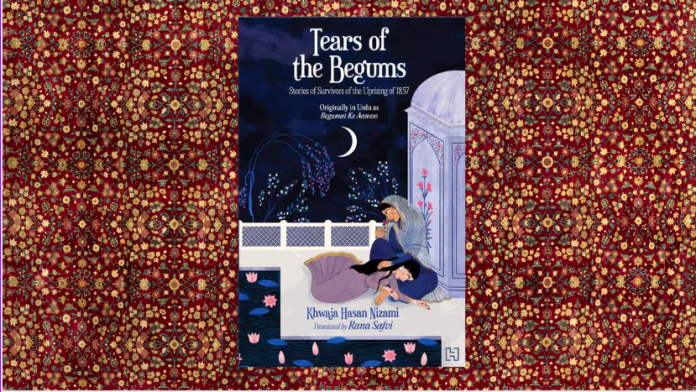Tears of the Begums: Stories of Survivors of the Uprising of 1857
by Khwaja Hasan Nizami, Translated by Rana Safvi
Publisher: Hatchette India
First published in 1922, Khwaja Hasan Nizami’s Begumat ke Aansoo is a collection of stories (in Urdu) based on the lives of the people who survived the Uprising of 1857 in Delhi. During this time of conflict and confusion, hundreds of Mughal royalty were uprooted from their cushioned lives and forced to weather harsh punishment, uncertainty and poverty.
The book opens with the beginning of the ghadar (Uprising) and Bahadur Shah Zafar fleeing for refuge to Humayun’s tomb. The UNESCO heritage site eventually sheltered hundreds of Mughal royalty, who today lie buried within its grounds. Thus, the tomb has aptly earned the epitaph of ‘the dormitory of Mughals’. Additionally, the Red Fort and the Salimgarh Fort housed thousands of refugees as well.
With this introduction the stage is set for the reader; now we step into the lives of the myriad sons, daughters, siblings, and spouses of the Emperor’s extended family. Reading these accounts reminded me of that popular saying from the story of David – Oh how the mighty have fallen! The poignant episodes from each tormented life are narrated
with nuance and a refined sensibility. They repeat in various ways the same sage counsel – One always has a choice. When faced with difficult times, you can choose to succumb to despair, you can make the best of what you’ve got (count your blessings) or you can turn your nose up in favour of your misplaced pride. These stories, in equal measure, capture the spirit of the nobles, who faced with the realities of losing their privilege, chose one or other of these options. In this sense, these stories read like timeless parables to me.
“…For hundreds of years, my ancestors ruled Hindustan through force and fear. Now it is time for others to rule. We will become the ruled and they shall be the rulers. There is no reason to mourn, for we too removed someone from the throne and destroyed their dynasty to establish ours.” Similar to these words spoken by the Badshah, I likewise found the lament of the other Mughals too echoing faith and forgiveness. There is a humble refrain of ‘life is transient’ in each survivor’s story, irrespective of their social or economic status.
The book swings easily between bleakness and glory. In each heartbreaking story, amid the terror and chaos is a sense of lost beauty and nostalgia. What I enjoyed a lot was the atmospheric element of the stories. Delhi was as much a prominent character lending to the people its charms, hopes and ambition. And so I returned again and again to the streets of the walled city of Shahjahanabad which were witness to opulence one day and rudely stripped bare the next.
Nizami was born two decades after the 1857 Uprising, but wrote 12 books on it, all based on eyewitness accounts. Begumat ke Aansoo is his most popular collection of stories and has been translated into numerous languages in the last century. Through rigorous research and by interviewing countless survivors, Nizami has documented the sad end of a glorious era in Indian history.
Equally commendable is the task that Rana Safvi (translator) has accomplished in this edition. It thrilled me to note that being published in 2022, this edition marks 100 years since the original was first published. Safvi is a historian herself and her incredibly lucid footnotes provide supplemental context to those who are new to the genre or culture. She has managed to uphold the authenticity of the stories by retaining many Urdu words in context and providing fascinating side-plots in her footnotes. In this skillful way, she has done a tremendous job of translating by not interfering with the original text.
Being a fan of historical literature, this book gave me lots to reflect on and learn. I would highly recommend this book to everyone! It is an important testament to an important part of our history.






RELATED ARTICLESMORE FROM AUTHOR
Kashmir: A Valley That Goes Beyond Personal Anger
Of Oppressor’s Body & Mind
Last Among Equals: Power, Caste & Politics in Bihar’s Villages